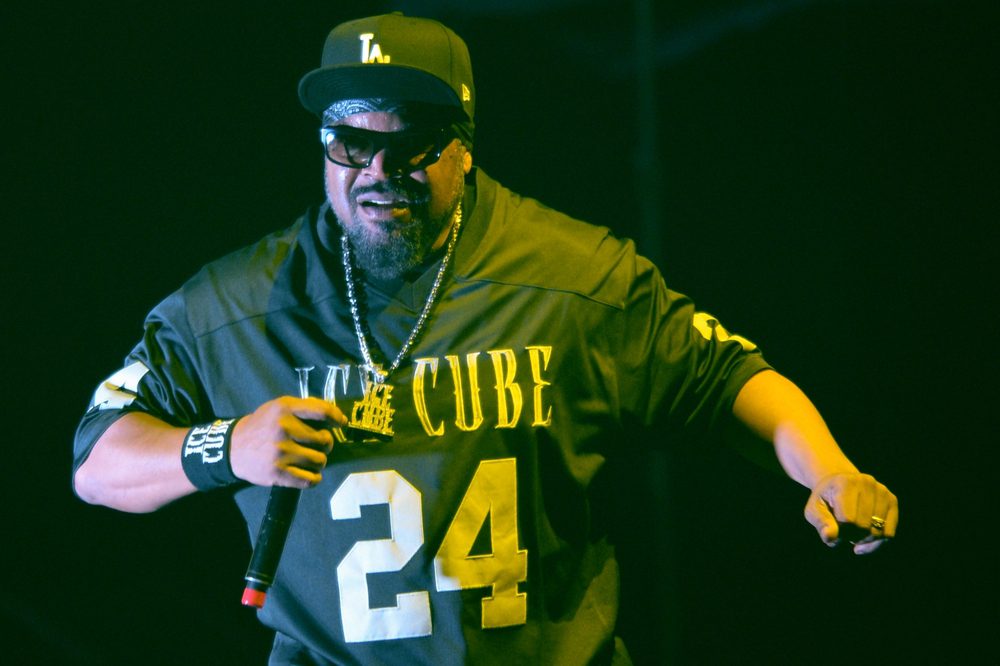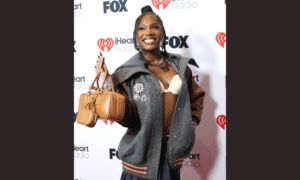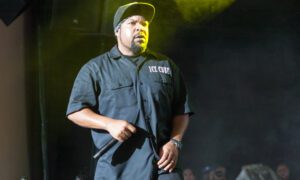
Ice Cube’s AmeriKKKa’s Most Wanted Turns 35: Still a Banger, Still Relevant
Back on May 16, 1990, Ice Cube dropped his solo debut, AmeriKKKa’s Most Wanted, and it hit harder than a sucker punch in a crowded club. Fresh off a messy split with N.W.A., Cube wasn’t just stepping away from his old crew—he was stepping into a new lane entirely. This wasn’t just a solo record—it was a statement, a protest sign wrapped in funk and fire.
Even now, the album feels fresh—essential listening that helped shape the future of gangsta rap, conscious hip-hop, and protest music.
Royalties, Rhymes, and Ruptures: Cube’s N.W.A. Split
How to Quit Your Rap Group (Like a Legend)
Ice Cube’s split from N.W.A. was more than messy—it was seismic. He didn’t just leave a group; he walked away from the biggest, most controversial rap act in the country while they were at their peak. At just 20 years old, Cube saw the contracts, saw the money wasn’t adding up, and bounced. No Twitter threads. No publicist spin. Just a clean break—and a notebook full of rhymes.
It wasn’t just about royalties. Cube was frustrated that Eazy-E and N.W.A.’s manager, Jerry Heller, were calling the shots and allegedly pocketing the lion’s share of profits. Cube had written a huge chunk of the group’s breakout album Straight Outta Compton, including verses for “Gangsta Gangsta,” “Express Yourself,” and “Fuck tha Police.” But when the checks came in, he saw crumbs.
He refused to sign a contract he didn’t understand—smart move—and instead, dipped out with no solo deal, no producer lined up, and no West Coast support. When Cube tried to get Dr. Dre to produce his debut, Heller reportedly blocked it. Dre wanted to work with him, but politics killed it. It was not a good day for Cube,
So what did Cube do? He got on a plane to New York.
This move was basically sacrilege at the time. West Coast rappers didn’t go east for beats. The styles were different, the sounds were different, and the coasts had a quiet rivalry brewing. People back home were literally laughing at Cube for the decision.
Enter Chuck D
Cube ran into him at Def Jam’s offices. Chuck knew what Cube was up against and brought him to Greene St. Studios, where Public Enemy was finishing up “Burn Hollywood Burn.” They let Cube drop a verse. It wasn’t just a feature—it was a trust fall. The Bomb Squad, Public Enemy’s legendary production team, were so impressed by Cube’s fire that they said, “We’ll do your whole album.”
Boom. Just like that, a coast-to-coast alliance was born.
Cube didn’t show up empty-handed. He had six 200-page notebooks full of rhymes. And he wasn’t there to coast on PE’s legacy—he was there to learn. Chuck D taught him how to build an album, not just a playlist. The Bomb Squad taught him how to dig for samples, think in layers, and use sound like a political weapon.
The result wasn’t just AmeriKKKa’s Most Wanted. It was a complete reinvention of what a West Coast rapper could sound like. Cube left L.A. as a ghostwriter and came back as a general.
Meanwhile, back in California, N.W.A. was watching—and not too happy. They fired back with “100 Miles and Runnin’” and dissed him on wax and in interviews. Cube kept cool, refusing to use AmeriKKKa as a diss album. (Though trust—he’d clap back later with “No Vaseline,” one of the coldest diss tracks in history.)
What makes this era legendary is that Cube didn’t just survive the breakup—he thrived. He took the risk, flipped the narrative, and made one of the most important hip-hop albums of all time. Not bad for a kid everyone said was crazy for leaving the most dangerous group in the game.
The Bomb Squad: Sonic Mayhem, By Design
Layered Like an Onion, Hits Like a Brick
Let’s talk about the Bomb Squad for a second—because their work on this album deserves its own star on the Hip-Hop Walk of Fame.
Made up of Hank Shocklee, Keith Shocklee, Eric “Vietnam” Sadler, and Chuck D, the Bomb Squad were pioneers of maximalist production. Think of their style like a collage of urban chaos: sirens, funk riffs, TV news clips, movie dialogue, screeching synths, and layers on layers of drum breaks. They didn’t make beats—they made soundtracks to revolutions.
And they didn’t just sample—they stacked samples. You weren’t hearing one loop over a drum track. You were hearing ten samples blended into something new and wild. It was like flipping through 30 TV channels at once, but it somehow made perfect sense.
When Cube flew to New York, he didn’t just walk into a studio and spit. The Bomb Squad gave him and Sir Jinx homework: a crate-digging mission. They were locked in a room and told, “Fill these crates with the sounds of your album.” That kind of sonic research is rare today. Cube didn’t just pick beats—he helped build them from scratch.
The result? A sound that was louder, rougher, and more intense than anything West Coast rap was doing at the time. Tracks like “AmeriKKKa’s Most Wanted” and “The Nigga Ya Love to Hate” hit with the energy of a riot and the complexity of a jazz symphony run through a meat grinder.
Cube Calls Out America: No Spellcheck Required
Triple K, Triple Threat: No Holding Back
That triple-K in AmeriKKKa’s wasn’t just for shock—it was calling out America’s legacy of white supremacy. In 1990, that was a bold move for a major-label artist. Before Rodney King. Before Trayvon. Prior to hashtags. Ice Cube said the quiet part out loud.
Ice Cube’s deliberate misspelling of “America” as AmeriKKKa in his debut solo album title was a bold and unflinching critique of systemic racism and white supremacy in the United States. By inserting “KKK”—a direct reference to the Ku Klux Klan—into the country’s name, Cube underscored the pervasive racial injustices that he perceived as deeply embedded in American society.
This provocative stance was evident throughout the album, particularly in tracks like “Endangered Species (Tales from the Darkside),” where Cube addresses police brutality and the marginalization of Black communities. In this song, he raps:
“Young nigga got it bad ’cause I’m brown”
This line highlights the racial profiling and discrimination faced by young Black men. Cube’s lyrics throughout the album serve as a raw and unfiltered commentary on the systemic issues affecting African Americans, predating many of the conversations that would gain prominence in later decades.
The album’s confrontational tone and unapologetic messaging challenged listeners to confront uncomfortable truths about race relations in America. By using his platform to spotlight these issues, Ice Cube positioned himself not just as a rapper, but as a vocal critic of societal injustices, setting a precedent for future artists to blend music with activism.
How Cube Went from Crew Cut to Culture King
From Ghostwriter to Guiding Voice
Cube didn’t sound like a professor on a mic—he sounded like your older cousin who’d seen too much and didn’t care if you were ready to hear it. Songs like “Endangered Species (Tales From the Darkside)” with Chuck D called out police violence years before body cams and hashtags became the norm.
“The Nigga Ya Love to Hate”: Cube’s Supervillain Origin Story
This opening track wasn’t just a banger—it was branding. Cube positioned himself as hip-hop’s anti-hero, leaning into controversy with confidence. Since then, artists from Eminem to Tyler, the Creator have used that same blueprint: offend, provoke, dominate.
Platinum Without Permission: Cube’s DIY Hit Parade
This album had no hits in the traditional sense. No radio play. No MTV love. But it still went platinum within months. All on the strength of street buzz, word-of-mouth, and cultural urgency. Cube proved you could go full guerrilla and still win.
Jokes, Jabs, and Jungle Gym Justice
Cube’s Fairytales Were Never for Kids
Even in his angriest moments, Cube knew how to clown. “A Gangsta’s Fairytale” flips childhood rhymes into ghetto parables. It’s funny, scary, and smart all at once. That mix of rage and satire would later be picked up by artists like Dave Chappelle, Donald Glover, and Kendrick Lamar.
West Coast Consciousness, Before It Was Cool
Before Kendrick dropped To Pimp a Butterfly and before 2Pac got political, Cube was already there—bringing militant energy to L.A. streets. He showed you could spit bars about drive-bys and about the system, and make it all feel connected.
1990’s Truth, Still Trending in 2025
“I’m only 19 but my mind is old.” That line? Still chills. Cube captured what it felt like to be young, Black, and already tired. Already done with the BS. It’s a line that feels more like prophecy in 2025.
From Tracks to Templates: Cube’s Cultural Drafting Table
AmeriKKKa’s Most Wanted was more than an album—it became a blueprint. You hear it in Kendrick. In Killer Mike. In Noname. Also, in JPEGMAFIA. And in every rapper who mixes message with menace. And even in the way hip-hop albums are structured now—with skits, soundbites, and cinematic sequencing—Cube helped pave the way.
Want to know more about how Cube evolved from a firestarter to a full-on cultural icon? Check out these 10 facts about “It Was a Good Day” that reveal even more layers.
Cube’s Protest Album Still Starts Fights at Family Reunions
Not Just a Solo Album—A Solo Revolution
This wasn’t just Cube proving he could go solo. This was him proving that hip-hop could be raw, unfiltered protest music and sell a million copies without a single compromise.
The Bomb Squad gave him the perfect soundtrack to do it: dense, wild, and loud as hell. It was like Public Enemy’s chaos met South Central’s reality—and the result still slaps today.
So yeah, it’s been 35 years. But AmeriKKKa’s Most Wanted hasn’t aged a day.
Crank it. And if you’re tuning in, check out our Throwback Hip-Hop Radio for more Cube, The Predator, and Death Certificate.
No filters. Just facts and funk.
More hip-hop culture and history









